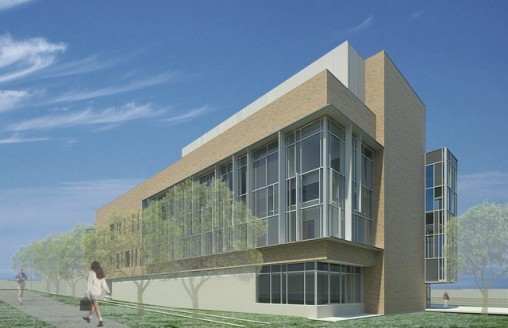 Groundbreaking for Wright State University’s new Student Success Center and Classroom Building is set for Oct. 11. The 67,000-square-foot, $14.3 million facility is expected to open sometime during the spring 2015 semester.
Groundbreaking for Wright State University’s new Student Success Center and Classroom Building is set for Oct. 11. The 67,000-square-foot, $14.3 million facility is expected to open sometime during the spring 2015 semester.
The Student Success Center and Classroom Building will include four active learning classrooms, a 225-seat auditorium, and informal student study areas. It will also become the new unified home for many vital student academic support services.
“One of the goals was to greatly increase the number of students who utilize these services,” said Thomas Sudkamp, Ph.D., Wright State vice president for curriculum and instruction. “In this building, students will be able to attend class, study and obtain academic support and advising in one place.”
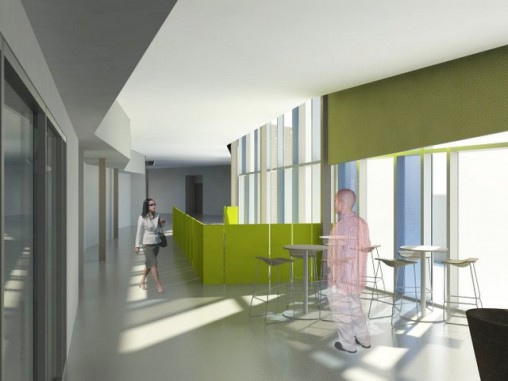 University College programs and services are currently scattered in four locations among three buildings. Advising and Transfer Services, First-Year Programs, the Student Academic Success Center and the Math Studio will now reside in one location. The Student Academic Success Center is the home of university tutoring services, supplemental instruction, the Math Learning Center and the University Writing Center.
University College programs and services are currently scattered in four locations among three buildings. Advising and Transfer Services, First-Year Programs, the Student Academic Success Center and the Math Studio will now reside in one location. The Student Academic Success Center is the home of university tutoring services, supplemental instruction, the Math Learning Center and the University Writing Center.
“The active learning classrooms in the new building will give many first-year students daily proximity to the wrap-around academic support services of University College, which emphasizes our focus on active cultures of learning,” said Tim Littell, University College assistant dean for programming.
University College programs are utilized by 6,500 students, with another 365 working as tutors, peer mentors and in other academic support roles. The current Math Studio, located in the Mathematics and Microbiology building, is full from 8 a.m. to 9 p.m. with students working at their own pace on computer workstations with instructors and tutors to enhance their mathematics background. The new building will provide expanded space for the “math emporium” model used in the Math Studio.
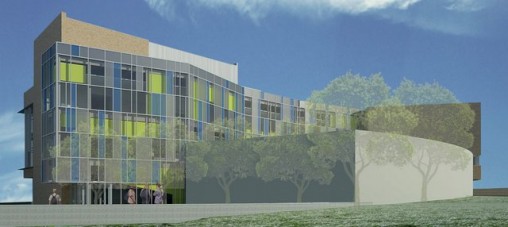 The new active learning classrooms will offer students a cutting-edge educational experience.
The new active learning classrooms will offer students a cutting-edge educational experience.
Sudkamp said these classrooms are configured to accommodate small groups working together rather than following the traditional lecture setup. Students prepare by reading and studying material before arriving for class. Class time is spent working together in peer groups under the professor’s guidance. In an active learning course, class time could be devoted to problem solving, topic discussion, a group project or any other active learning activity.
“The classrooms will be a very interactive environment,” Sudkamp said. “It will become a hands-on experience with students and faculty collaborating.”
Classroom tables are outfitted with a circle of laptop computers. Each group will have a SmartBoard projector and screen to help display their work or explore the topic at hand. There are currently three busy active learning classrooms on campus.
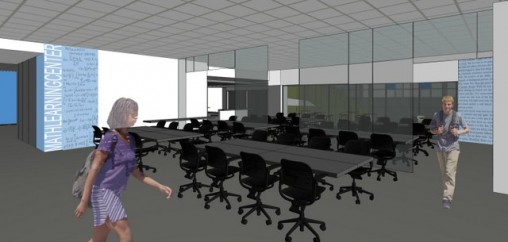 “You might see a group of Engineering and Computer Science students working together on their senior design projects,” said Matt Kijowski, senior computer systems administrator. “There is a lot of learning that takes place through peer interaction.”
“You might see a group of Engineering and Computer Science students working together on their senior design projects,” said Matt Kijowski, senior computer systems administrator. “There is a lot of learning that takes place through peer interaction.”
The multi-use building will provide “huddle” spaces for study and discussion, a study room for Raider athletes, a conference room for military and other training sessions, a courtyard, universal access and family restrooms, and a tunnel that connects to University Hall and the rest of the campus tunnel system.
“This building is also very energy efficient and atmospherically friendly,” said Brad Bubp, senior facilities planner. “All rainwater will be filtered through a rain garden before it enters the sewer system. There is efficient lighting. Everywhere you look, you will see evidence of best practices in designing a building today.”
Bubp pointed out that new trees will be planted to replace those lost while preparing for the building’s construction. Sixteen trees have been moved from the site to the alumni grove.
The planning process involved many people over the last four years, according to Bubp.
“I believe this building will satisfy a lot of needs. I’m proud of the way it finally came together.”
Annette Miller Architects designed the building and Monarch Construction of Cincinnati was selected for the construction.
Learn more and see more artist renderings >>

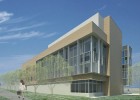
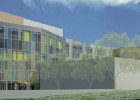
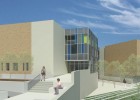
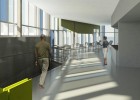
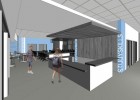
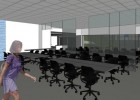
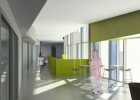
 Milling around
Milling around  Wright State recognizes Nursing Professor Kim Ringo for advancing international student success
Wright State recognizes Nursing Professor Kim Ringo for advancing international student success  Wright State honors graduating students for distinguished doctoral dissertations
Wright State honors graduating students for distinguished doctoral dissertations  Top 10 Newsroom videos of 2025
Top 10 Newsroom videos of 2025  Museum-quality replica of historic Hawthorn Hill donated to Wright State
Museum-quality replica of historic Hawthorn Hill donated to Wright State 